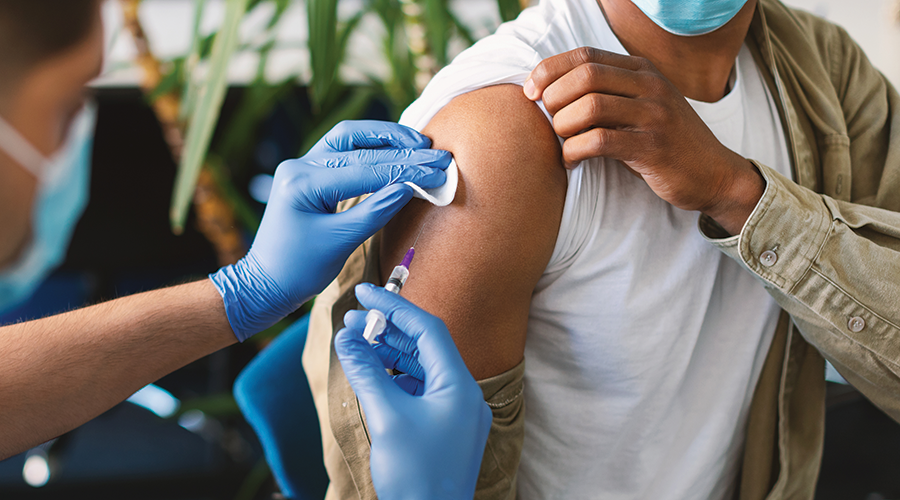During the pandemic, you stepped up and provided access to COVID testing in your community; and in other communities, the ability to partner with providers for test and treat. That’s a big deal.
By continuing to work with community partners, you can strategize and address challenges and needs of the community while increasing vaccine access and immunization rates. Here’s how:
Know the regulations in your state
While all 50 states allow pharmacists to administer immunizations, some have limitations. For instance, some states might have certain types of vaccines that can be administered or age limitations for patients. Check to see if your state requires pharmacists to have a collaborative practice agreement, protocol, or standing order. If they don’t, you can find model standing orders available at the Immunization Action Coalition’s website, immunize.org.
Take courses and become certified
If you want to administer immunizations, you’ll need to be certified by an Accreditation Council for Pharmacy Education (ACPE) accredited immunization and delivery course. You can find these courses at:
- Your state pharmacy association
- A local university or school of pharmacy
- American Pharmacists Association (APhA)
- Other pharmacy organizations
Be aware that you’ll also need to be CPR/BLS certified. You can receive your certification through the American Heart Association’s or American Red Cross’ Basic Life Support for Healthcare Providers course, and then maintain your current certification.
Obtain a standing order from a licensed physician
Whether it’s required by your state or not, standing orders are encouraged because they allow you to administer vaccines according to a physician-approved protocol without a direct prescription or order. You can refer to the Immunization Action Coalition’s document on Using Standing Orders for Administering Vaccines: What You Should Know.
Your state may require that you complete and submit a state board application. You might also be required to submit your application and required documents to your state board. You can find state-specific guidelines at naspa.us/blog/resource/pharmacist-authority-to-immunize.
COVID-19 vaccines will target the JN.1 variant instead of the KP.2 strain, according to the Food and Drug Administration (FDA). Advisers from the FDA follow the European and World Health Organization recommendations, and their advisers agreed upon targeting the older JN.1 variant over the newer KP.2 strain.
Now in its fifth year, subvariants of the Omicron strain continue to drive infections in the U.S. The vaccines are still expected to be effective at preventing hospitalization, severe disease, and death.
There are three COVID-19 vaccines that will be in use in the U.S. in 2024-2025:
Pfizer Comirnaty COVID-19 Vaccine (mRNA)
(12 years and up): Do not freeze
Earlier this year, the FDA approved Comirnaty. Then, on August 22, the new mRNA Covid-19 vaccines (2024-2025 formula) were approved to include a monovalent (single) component that corresponds to the Omicron variant KP.2 strain of SARS-CoV-2. The mRNA COVID-19 vaccines are updated with this formula to more closely target the current variants that are circulating and provide better protection against serious consequences of COVID-19.
One of the updated mRNA COVID-19 vaccines includes Comirnaty, a full FDA-approved vaccine for use in people 12 years of age and older. Those who are 12 and up are eligible to receive a single dose of the updated and approved Comirnaty. If previously vaccinated, the dose is administered at least 2 months after the initial dose of any COVID-19 vaccine.
Pfizer-BioNTech COVID-19 Vaccine
(5 to 11 years of age), EUA
The FDA approved a single dose of Pfizer-BioNTech COVID-19 vaccine for individuals ages 5 to 11 years old. This is a messenger RNA (mRNA) vaccine, which uses a relatively new technology. Therefore, it must be stored in freezer-level temperatures, which can make it harder to distribute than some other vaccines.
Who can get it:
- Anyone who is 6 months and older can get the vaccine, including those who are pregnant, breastfeeding, or might become pregnant. However, anyone who recently had COVID-19 may need to consider waiting to get their vaccination by 3 months.
- Children ages 6 months to 4 years need 2 to 3 doses of COVID-19 vaccines. This includes at least one dose of the 2024-2025 updated vaccine.
- Those who are 6 months or older and have a weakened immune system need at least one dose of the updated COVID-19 vaccine. They may get additional doses depending on the number of doses they’ve previously received. Those who are immunocompromised and 65 or older should get an additional dose.
- Ages 5 years and older should have one dose of the 2024-2025 Pfizer COVID-19 vaccine.
- Adults 65 and older who are not moderately or severely immunocompromised need one dose of the 2024-2025 Pfizer COVID-19 vaccine.
Pfizer-BioNTech COVID-19 Vaccine (6 months through 4 years of age), EUA
- Individuals who are unvaccinated need three doses of Pfizer-BioNTech COVID-19 Vaccine (2024-2025 formula) administered: The first two doses are administered three weeks apart. The third dose is administered at least 8 weeks after the second dose.
- Those who have received one previous dose of any Pfizer BioNTech COVID-19 Vaccine that’s no longer authorized for use in the U.S.: Two doses of Pfizer-BioNTech COVID-19 Vaccine (2024-2025 formula) are administered. The first dose of Pfizer-BioNTech COVID-19 Vaccine (2024-2025 formula) is administered three weeks after receiving the previous dose and the second dose is administered at least 8 weeks later.
- Individuals who have received two or more previous doses of any Pfizer BioNTech COVID-19 vaccine that’s no longer authorized for use in the United States: A single dose of Pfizer-BioNTech COVID-19 vaccine (2024-2025 formula) is administered at least 8 weeks after receipt of the last previous dose.
Moderna: Spikevax (mRNA)
Full approval was granted by the FDA for the 2024-2025 Moderna vaccine, Spikevax, for people 12 and older. Moderna uses the same mRNA technology as Pfizer and a similar high efficacy at preventing symptomatic disease. Be aware that it does need to be shipped and stored in freezer-level temperatures. After it’s shipped, it needs to be refrigerated for up to 60 days.
Moderna’s COVID-19 vaccine has been updated over time to target new virus variants. In September 2022, the vaccine was replaced by bivalent vaccines that are designed to prevent both the original virus and the Omicron variants BA.4 and BA.5. In September 2023, updated vaccines replaced the bivalent shots with vaccines targeting the SBB lineage of the variant Omicron.
While the original and bivalent vaccines are no longer used, a decision hasn’t yet been made whether updated shots will be administered yearly like flu shots.
Who can get it:
Moderna’s Spikevax vaccine can be given to people ages 12 and older. However, the CDC has specific recommendations for the following groups, noting that anyone who recently had COVID-19 may need to consider delaying their vaccination by 3 months.
- Children ages 6 months to 4 years who are not moderately or severely immunocompromised need two doses of the Moderna COVID-19 vaccines, including at least one .25 mL dose of the 2024-2025 updated vaccine.
- Those who are 6 months or older and moderately or severely immunocompromised need at least one dose of the updated vaccine and may get additional doses depending on the number of doses they’ve previously received. Those who are immunocompromised and 65 or older should get an additional dose at least two months after their first dose.
- People between 5 and 64 (including those who are pregnant, breastfeeding, or might become pregnant)
may get one dose of the 2024-2025 updated Moderna COVID-19 vaccine. - Adults who are 65 and older and not moderately or severely immunocompromised need one dose of the 2024-2025 updated vaccine.
Novavax
The Novavax vaccine is a protein adjuvant and had 90 percent efficacy in its clinical trial. It performed almost
as well as the mRNA vaccines in their early trials. It’s much simpler to make compared to some of the other vaccines. It can also be stored in a refrigerator at a temperature between 36 and 46 degrees, which makes it much easier to distribute.
The earlier Novavax authorization was amended by the FDA to allow for a new adjuvanted 2024-2025 Novavax vaccine for ages 12 and older to target the XBB.1.5 strain in October 2023, which was a few weeks after the updated mRNA shots were approved. The Novavax vaccine is the only non-mRNA updated COVID-19 vaccine that’s available in the U.S. since the previous Novavax vaccine is no longer authorized.
Who can get it:
- Novavax can be given to anyone who is 12 or older and who was previously vaccinated with any COVID-19 vaccine. They can get one dose of the 2024-2025 updated vaccine and may need more depending on the number of previous COVID-19 vaccines they’ve received.
- Those who haven’t ever been vaccinated with any COVID-19 vaccine may get two doses of the Novavax updated vaccine (administered eight weeks apart).
- Anyone who is moderately or severely immunocompromised needs at least one dose of the 2024-2025 updated Novavax vaccine and may need more depending on their COVID-19 vaccination history.
Flu Vaccine Updates
Annual flu vaccines for 2024-2025 have also been updated, and the CDC recommends everyone 6 months and older receive an updated flu vaccine. This will reduce the risk of influenza and its potentially serious complications during the colder months.
The updated 2024-2025 flu vaccines will all be trivalent and will protect against three viruses: H1N1, H3N2, and a B/Victoria lineage virus.
Most people only need one dose of the flu vaccine each season. The CDC recommends flu vaccination as long as influenza viruses are circulating. However, September and October are still the best times for most people to get their vaccine. July and August are not recommended months for vaccination for most people, however, there are several considerations for certain groups during those months.
- Those who are pregnant and in their third trimester during those months can get a flu vaccine in July or August to protect their babies from flu after birth, when they’re too young to get vaccinated.
- Children who need two doses of the flu vaccine should get their first dose as soon as it becomes available. Their second dose, however, must wait until at least four weeks after the first.
- Giving vaccinations in July or August is considered for children who have healthcare visits during those months if they might not have another opportunity to get the vaccine.
- Vaccination in July and August should be avoided for adults (especially 65 years old and older) and pregnant people in the first and second trimester unless it won’t be possible to vaccinate in September or October.
AstraZeneca is offering FluMist Quadrivalent for the 2024-2025 flu season. FluMist is a vaccine that’s sprayed into the nose to help against influenza. FluMist Quadrivalent provides protection against four influenza strains in people 2-49 years of age.
CSL Seqirus began shipping out its three influenza vaccine options on July 9. The company offers Flucelvax, noted as the first and only cell-based influenza vaccine and Fluad, which is recommended by the CDC Advisory Committee on Immunizaion Practices (ACIP) for people 65 and older.
CSL Seqirus also makes the egg-based vaccine, Afluria, for people six months of age and older.
Sanofi began its initial vaccine shipments on July 10 and has more planned through October. Sanofi’s 2024-2025 flu vaccine portfolio includes Flublock, a quadrivalent shot made using insect cells, along with standard and high-dose versions of its Fluzone.
GSK began shipping its vaccines on July 11 after a licensing and lot-release approval from the FDA. The company markets Flulaval and Fluarix and expects to distribute more than 36 million doses in the U.S. this flu season.
Multi-Dose vs. Single-Dose Vials
With vaccine season just around the corner, it’s always good to go over the importance of safe injection practices in your pharmacy. Knowing how to use multi-dose vaccine vials safely and correctly is crucial.
Multi-dose vaccine vials are used more than once to vaccinate multiple people, so a fresh needle and fresh syringe need to be used each time. A specific set of safety procedures are required and need to be used every time you prepare to give a vaccine. This helps ensure they don’t become dirty or contaminated.
Routine Vaccines
It’s important for your patients to protect their health, and getting vaccinated is one of the safest ways. Vaccines help prevent catching and spreading serious diseases that can result in poor health, missing work, expensive medical bills, and the inability to care for family.
Your authority to prescribe vaccines and administer a vaccine without a patient-specific prescription from another healthcare provider can vary by vaccine or the patient’s age for each state.
How to Safely Use a Multi-Dose Vaccine Vial:
- Always prepare multi-dose vial injections away from patient care spaces in a clean, designated area
- Clean your hands before touching the vial
- Check the label to make sure it’s a multi-dose vaccine vial
- Check to make sure the vaccine is not expired or “beyond use”
- Look and see if the vaccine appears the way the vaccine maker tells you it should
- Use brand-new, sterile needles and syringes for every vaccine dose
- Disinfect the top part of the vial (the vial stopper) with an alcohol prep pad—every time
- Make sure the top is dry before inserting the needle in it
- When you first put a needle into the vial, write the date and time on the label
- Follow the vaccine maker’s instructions for storage
- Never “pool” doses (combine partial doses from multiple vials to make one dose for a patient)
The routine vaccines recommended for adults, other than flu and COVID vaccines, include:
- Chickenpox vaccine (varicella)
adults between 19 and 43 - Hepatitis B:
adults between 19 and 59 - HPV vaccine (human papillomavirus):
adults ages 19 to 26 - MMR vaccine (measles, mumps, and rubella):
adults ages 19 and up - Tdap vaccine (tetanus, diphtheria, and whooping cough) or Td (tetanus, diphtheria):
adults every 10 years - Respiratory Syncytial Virus Vaccines (RSV):
adults 60 and up - Shingles (varicella-zoster):
adults ages 50 and older - Pneumococcal vaccines (PCV15, PCV20, PCV23)
adults ages 65 and older - MenB Vaccine (meningococcal disease):
adults up through 23 years of age
More articles from the September 2024 issue:
- Peripheral Artery Disease
- PBMs Exposed
- Cybersecurity in Your Pharmacy
- Diagnosing Alzheimer’s Disease
- Patient Medication Reviews
- A New Direction for Continuous Glucose Monitors
- The Prevalence of Osteoarthritis
- Vaccine Overview 2024-25
A Member-Owned Company Serving Independent Pharmacies
PBA Health is dedicated to helping independent pharmacies reach their full potential on the buy-side of their business. Founded and run by pharmacists, PBA Health serves independent pharmacies with group purchasing services, wholesaler contract negotiations, proprietary purchasing tools, and more.
An HDA member, PBA Health operates its own NABP-accredited warehouse with more than 6,000 SKUs, including brands, generics, narcotics CII-CV, cold-storage products, and over-the-counter (OTC) products — offering the lowest prices in the secondary market.












